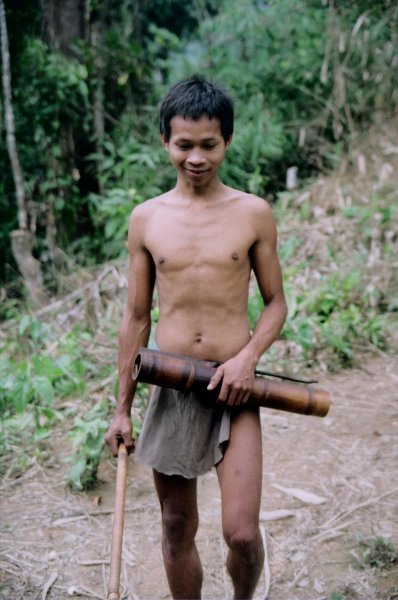South Palawan
The rugged mountains and virgin rainforest in the south of the Phillipines‘ Palawan island are home to the Palawan people who live very isolated lives in small, traditional villages scattered throughout the jungle. Most remain unconverted to Christianity and some communities are many hours or even days walk from the nearest road. They hunt using blowguns, or a home made instrument like a giant hair brush for catching bats and some groups live in caves for part of the year. The traditional loincloth pictured below is, however, now worn by less than one in ten people.
The most well-known and easiest to reach group of Palawan is the so called Tao’t Batu / Tao’t Bato / (probably most correctly) Taaw’t Bato. Their name means people of the rock and they are so-called due to the fact that they live in caves during the wet season. They are not, however, a separate tribe from the Palawan people.
The Tao’t Batu live in the Signapan Basin near Mount Mantalingajan (one of the hardest to scale peaks in the Philippines) and are accessible by a 3 – 6 hour trek through the jungle from Barangay Ransang. To get to Barangay Ransang there is a 9-hour bus on a terrible road from Puerto Princesa, Palawan’s capital, or slightly more regular buses from Puerto Princesa to Rizal where you can change for a jeepney to Ransang. Lots of boats go to Puerto Princesa from Manila, including the very modern, very safe but slightly more expensive SuperFerry. There is also an old, dirty boat called the Milagrosa which sails to Puerto Princesa twice a week for 36 hours across rough open seas from Iloilo on Panay. You can of course also fly with Cebu Pacific.
In Rizal ask for Bojie’s Place if you need to spend the night. Bojie can also organise an English-speaking guide to the Tao’t Batu but it’s about five times as expensive as taking a guide from Ransang. The only guy in Ransang who speaks English is called Buano. His English is pretty limited so in this respect a guide from Rizal would be better. However, Buano has the advantage that he himself is Tao’t Batu so your stay will be more pleasant if you go with him and you are more likely to be invited into people’s homes. If you turn up with a Rizal guide you will most likely have to bring your own tent and sleep separately.
The Tao’t Batu are now quite used to seeing tourists (although they still haven’t received a mention in the Lonely Planet). Therefore, particularly if you arrive with anyone other than Buano as a guide, expect to be asked for money to photograph certain things and people. For anyone wanting to get to more remote groups of Palawan, however, the Tao’t Batu area may be a good starting point. Talk to Buano and a local man called Tumihay about it. They may at first tell you its not possible, not exactly understanding what you mean, but if you repeatedly explain what you want and make it clear that you’re willing to pay the guide then you should be able to work something out. For this some knowledge of Tagalog or a guide with good English is helpful.
There are rumours of other tribes living in the area – The Konoy, the Tao’t Daram and the Tao’t Arib. Whether any of them really exist or not is dubious, but an anthropologist who spent some time in the area told me that they did and he had visited them. When I asked people in remote Palawan communities about them, they were able to point to mountains where the Tao’t Daram and Tao’t Arib lived and said they had had interactions with them. On the other hand people in Rizal told me the Tao’t Daram were just a legend and another anthropologist told me that Konoy is just a word meaning “hick” or “upriver person”.
Another access point for the Tao’t Batu and Palawan areas is Sicud a little further south than Rizal, although there is even less infrastructure here than in Rizal and Ransang. Going much further south is not recommended as parts of the jungle are still unexplored and are occasionally used by Islamic extremists. The islands around the far south of Palawan are also renowned for piracy.
There is an extremely vicious strain of malaria in these jungles which killed an entire team of journalists a few years ago. Don’t even think of coming without taking all the precautions.
Click here for my blog about South Palawan. It’s 4177 words and 19 photos.

Leave a Reply